
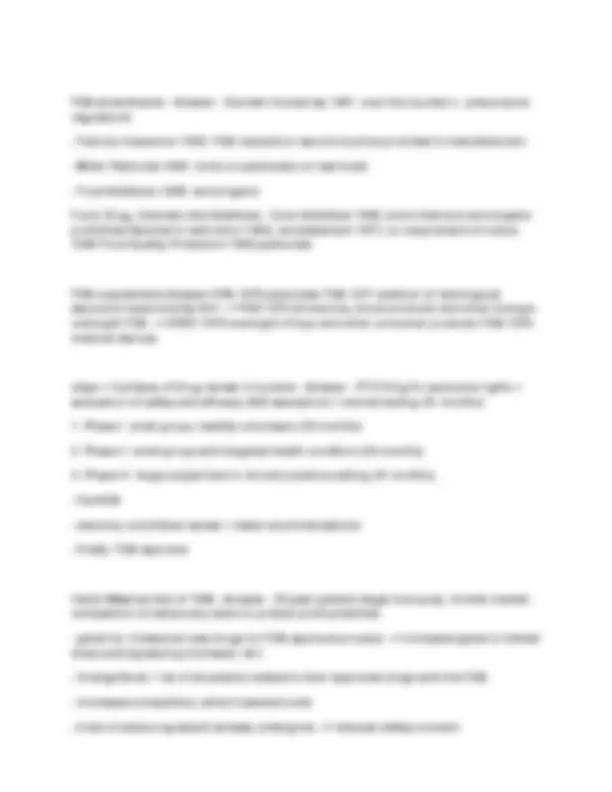
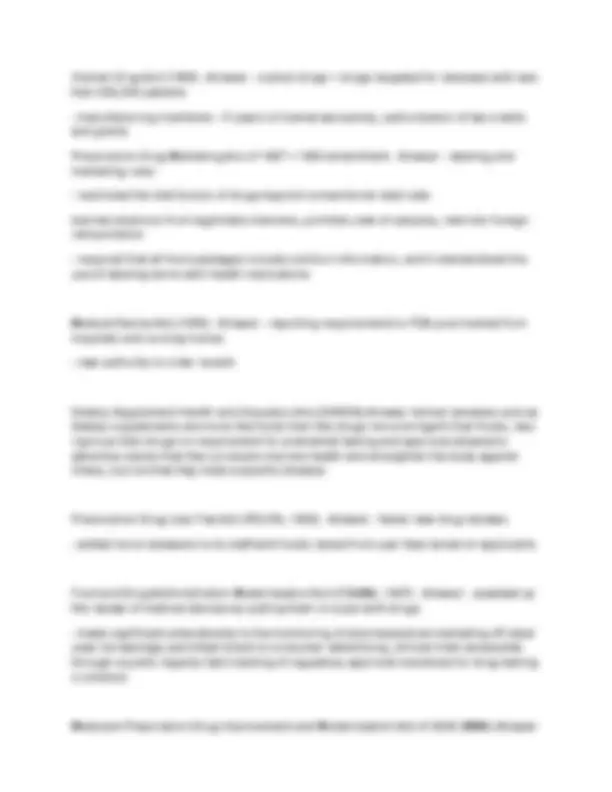
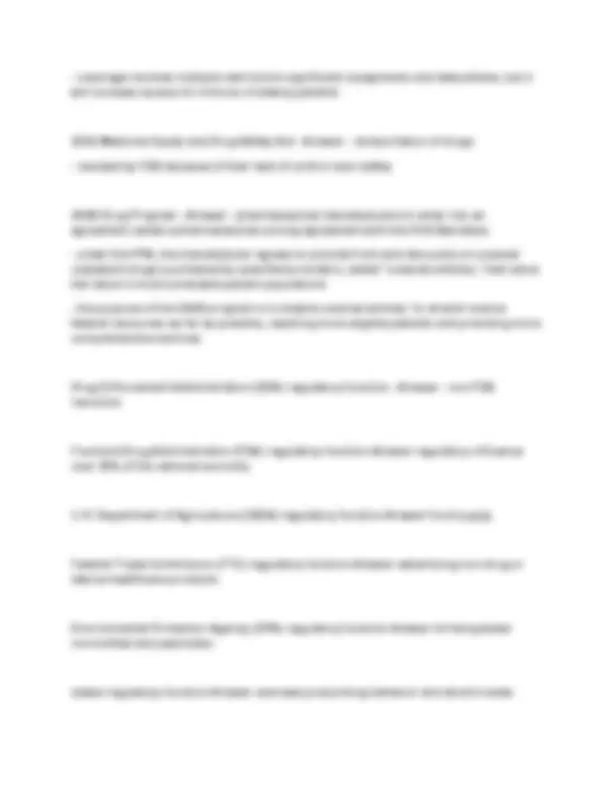
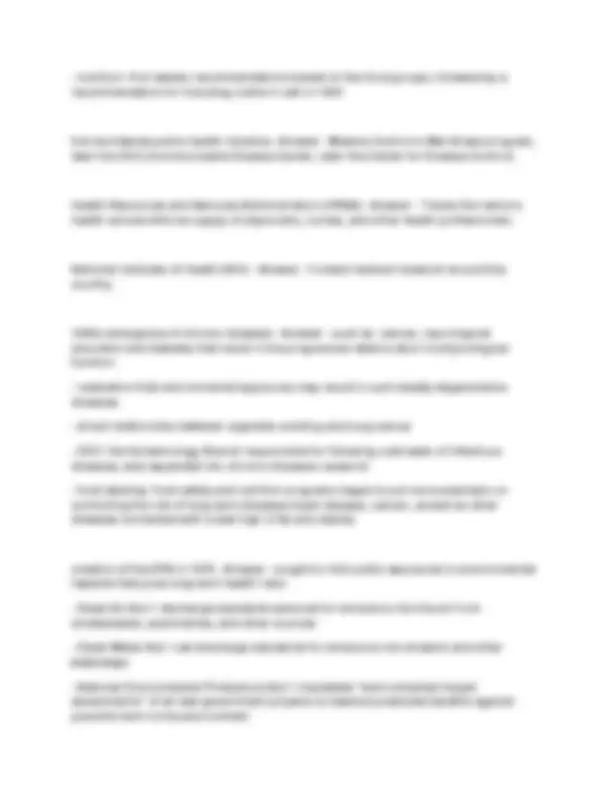
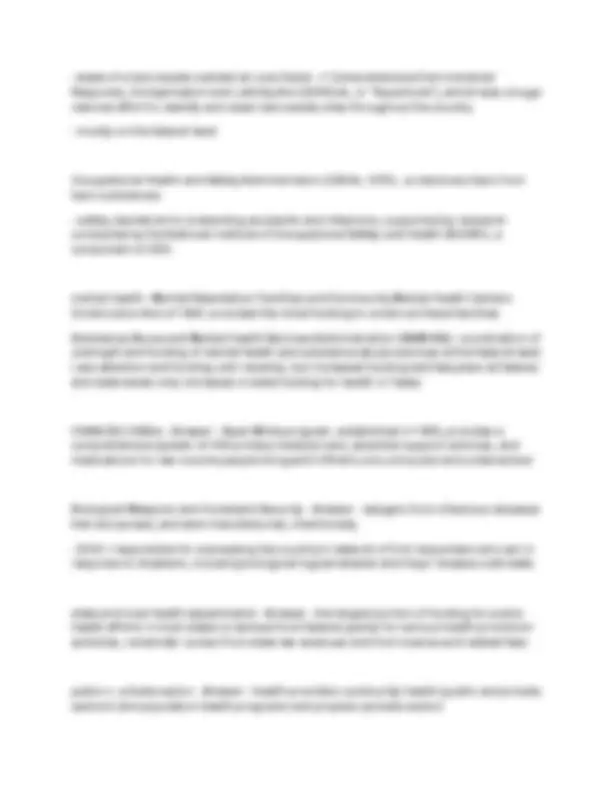
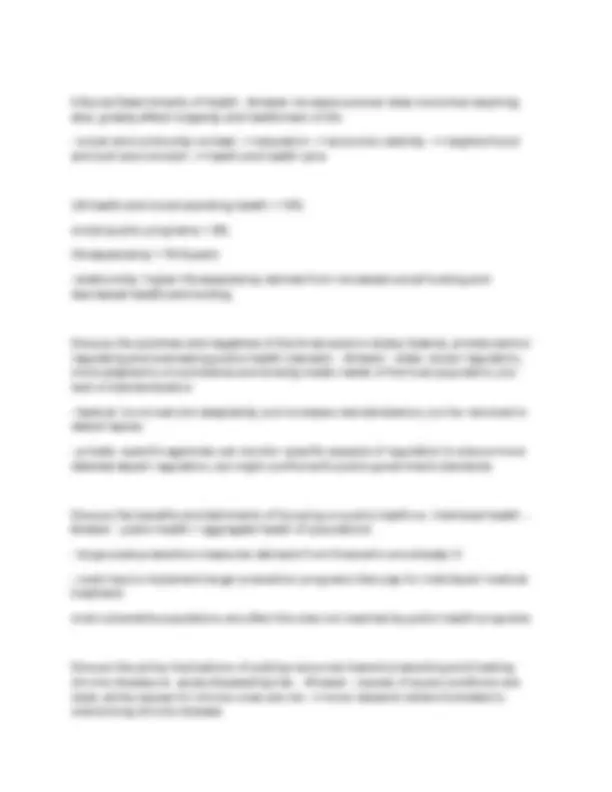
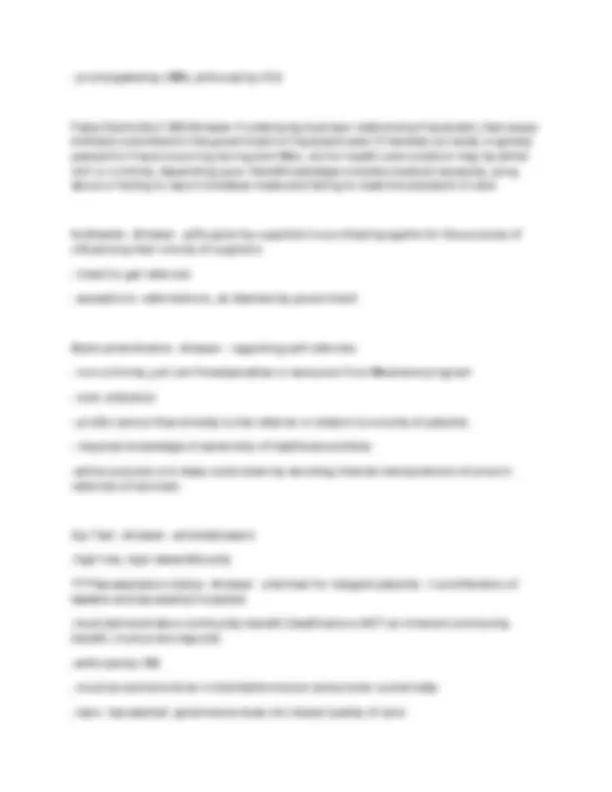
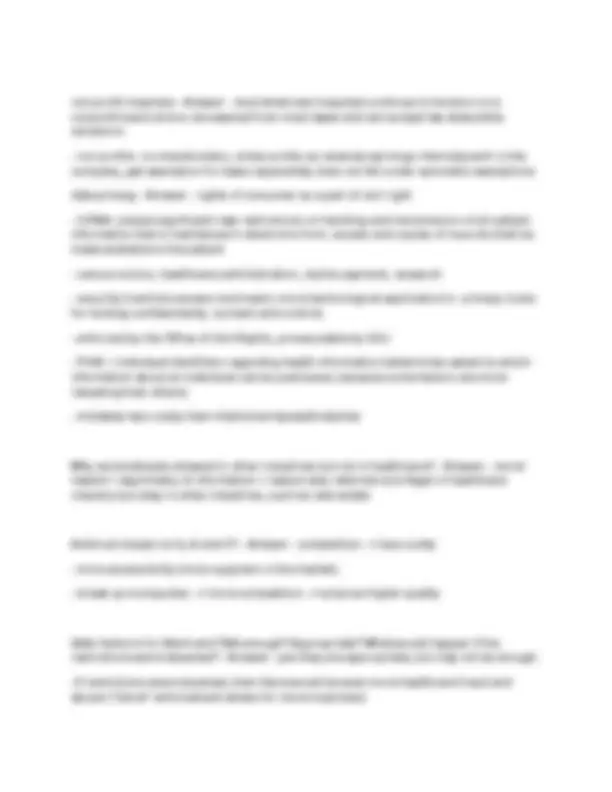
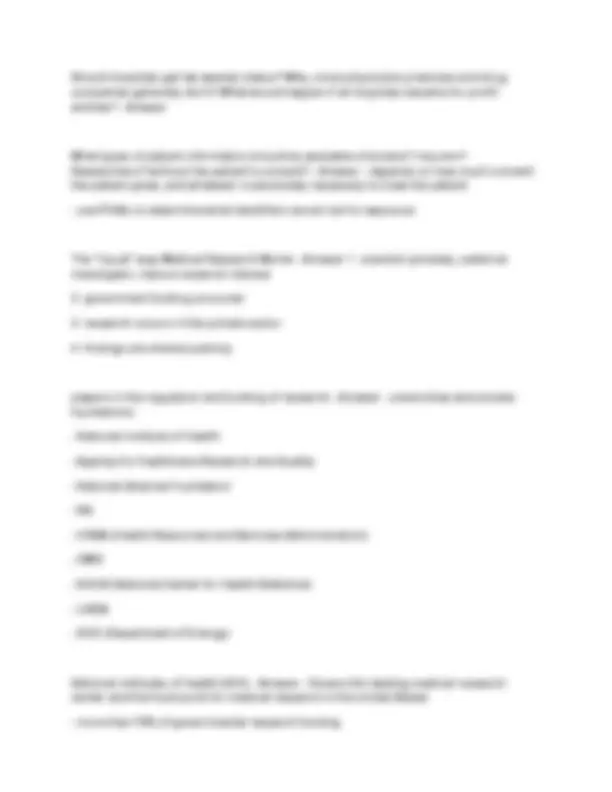
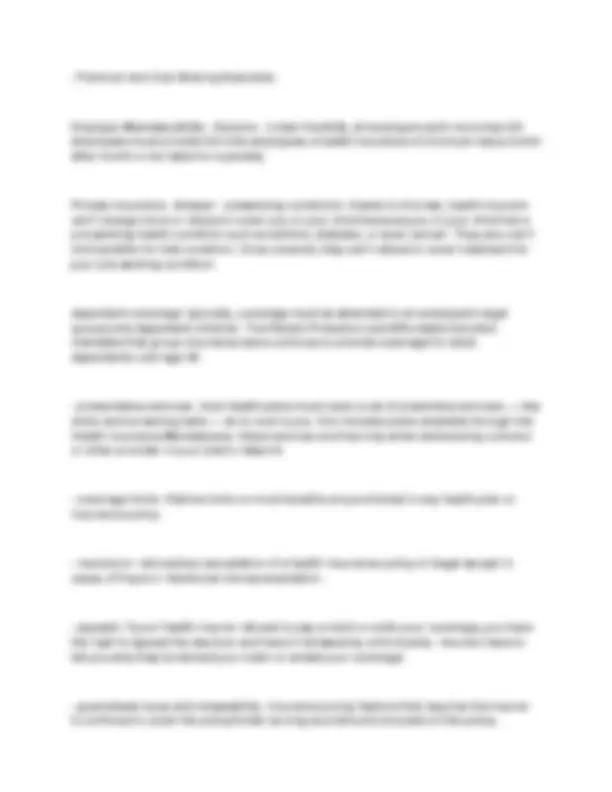

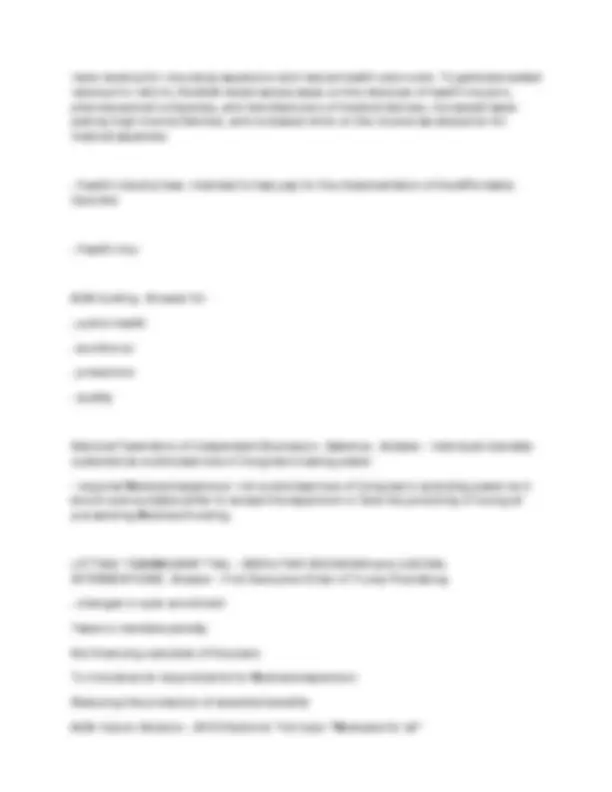
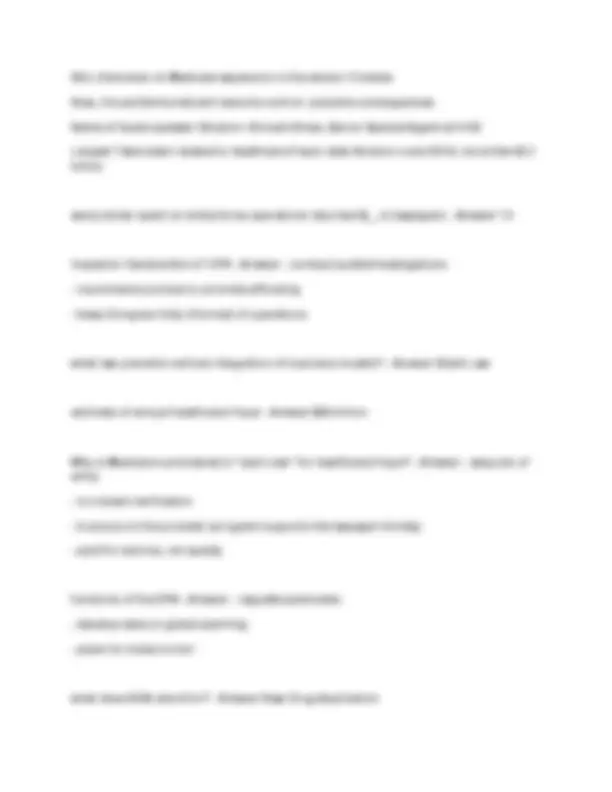
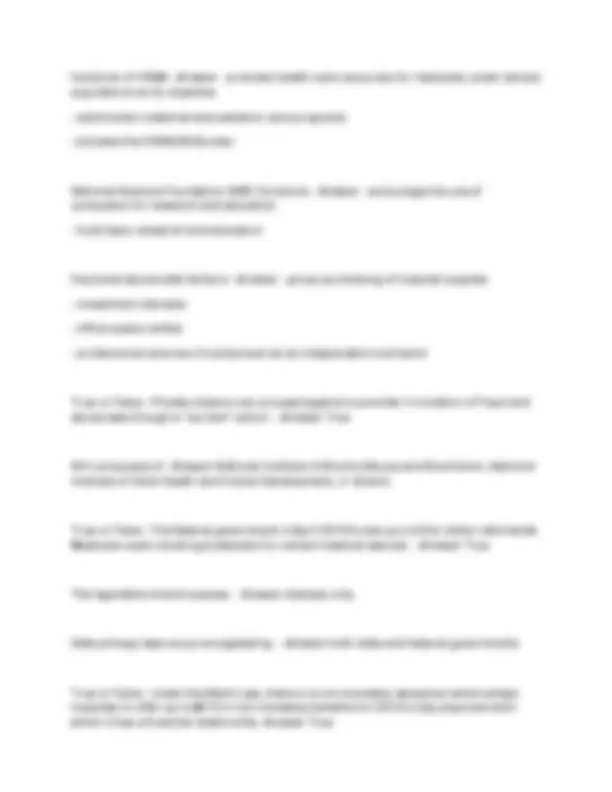


Study with the several resources on Docsity

Earn points by helping other students or get them with a premium plan


Prepare for your exams
Study with the several resources on Docsity

Earn points to download
Earn points by helping other students or get them with a premium plan
Community
Ask the community for help and clear up your study doubts
Discover the best universities in your country according to Docsity users
Free resources
Download our free guides on studying techniques, anxiety management strategies, and thesis advice from Docsity tutors
A comprehensive overview of the historical development and regulatory landscape of food and drug regulations in the united states. It outlines key legislation, landmark events, and regulatory agencies involved in ensuring the safety and efficacy of food and drugs. The document also explores contemporary issues such as the opioid crisis, genomic drug regulation, and the role of economic factors in drug approval.
Typology: Exams
1 / 22

This page cannot be seen from the preview
Don't miss anything!















Common Rule - name used for the Federal Policy for the
Protection of Human Subjects
issues related to drug/health product regulation - Answer - safety and efficacy
history of regulations - Answer Imports Drug Act of 1848 --> formation of USDA Bureau of Chemistry in 1862 --> Biologics Control Act of 1902 --> Pure Food and Drug Act of 1906 --> Shirley Amendment of 1912 --> Harrison Narcotics Tax Act of 1914 --> FDA formation in 1930 --> Food, Drug, and Cosmetic Act of 1938 --> Wheeler-Lea Act --> Required PTO Filing in 1962
Imports Drug Act (1848) - Answer - restrict importation of foreign drugs
USDA Bureau of Chemistry (1862) - Answer - inquiry into the safety of food, drugs, and animal feed at the federal level
Biologics Control Act (1902) - Answer - due to faulty production of diphtheria vaccine, first federal law to regulate a pharmaceutical product
Pure Food and Drug Act (1906) - Answer - in reaction to Upton Sinclair's novel "The
Jungle" depicting unsafe and unsanitary conditions in the meat packing industry
Shirley Amendment (1912) - Answer - outlawed false therapeutic claims that were deliberately designed to deceive the consumer
Harrison Narcotics Tax Act (1914) - required prescriptions before patients could obtain products containing more than minimal amounts of narcotic substances
FDA formation (1930) - set standards for packaging of most canned foods
Food, Drug, and Cosmetic Act (1938) - response to toxic antibiotics that killed 107 children
Wheeler-Lea Act - Answer - authorized the Federal Trade Commission (FTC) to regulate advertising of products subject to FDA oversight other than prescription drugs
Mandated PTO Filings 1962 - Answer - Kefauver-Harris Amendments: response to thalidomide babies, shift from safety to efficacy, retroactive review of 24 years, rejected FDA 60 day review requirement
Orphan Drug Act (1983) - Answer - orphan drugs = drugs targeted for diseases with less than 200,000 patients
Prescription Drug Marketing Act of 1987 + 1990 amendment - Answer - labeling and marketing rules
banned diversion from legitimate channels, prohibits sale of samples, restricts foreign reimportation
Medical Device Act (1990) - Answer - reporting requirements to FDA post market from hospitals and nursing homes
Dietary Supplement Health and Education Act (DSHEA) Answer herbal remedies sold as dietary supplements are more like foods than like drugs more stringent than foods, less rigorous than drugs no requirement for premarket testing and approval allowed to advertise claims that their products improve health and strengthen the body against illness, but not that they treat a specific disease
Prescription Drug User Fee Act (PDUFA, 1992) - Answer - faster new drug reviews
Food and Drug Administration Modernization Act (FDAMA, 1997) - Answer - speeded up the review of medical devices by putting them on a par with drugs
Medicare Prescription Drug Improvement and Modernization Act of 2003 (MMA) Answer
2000 Medicine Equity and Drug Safety Act - Answer - reimportation of drugs
340B Drug Program - Answer - pharmaceutical manufacturers to enter into an agreement called a pharmaceutical pricing agreement with the HHS Secretary
Drug Enforcement Administration (DEA) regulatory function - Answer - non-FDA narcotics
Food and Drug Administration (FDA) regulatory function Answer regulatory influence over 25% of the national economy
U.S. Department of Agriculture (USDA) regulatory function Answer food supply
Federal Trade Commission (FTC) regulatory function Answer advertising non-drug or device healthcare products
Environmental Protection Agency (EPA) regulatory function Answer drinking water non-bottled and pesticides
states regulatory function Answer oversees prescribing behavior and alcohol sales
first permanent state health board established in? - Answer - Massachusetts, 1869
earliest federal role in public health regulation - Answer - decision to centralize the administration of marine hospitals under a supervising surgeon general of the Marine Hospital Service in 1870
state health departments grew in response to? - Answer - emergence of the germ theory of disease
Public Health Service (PHS) - Answer - given power to investigate the spread of diseased, including the involvement of sanitation, sewage and pollution in lakes/streams
first vaccination - Answer - 1796, smallpox
World War I - Answer - attention focused on venereal disease and sex education
epidemiology - Answer - tracks national disease outbreaks
Corps of Public Health Professionals - Answer - Marine Hospital Service personnel
USDA's regulatory and inspection roles - Answer - response to Upton Sinclair's "The Jungle", which exposed unsanitary and dangerous conditions in meatpacking industry
first worldwide public health initiative - Answer - Malaria Control in War Areas program, later the CDC (Communicable Disease Center, later the Center for Disease Control)
Health Resources and Services Administration (HRSA) - Answer - Tracks the nation's health care workforce supply of physicians, nurses, and other health professionals.
National Institutes of Health (NIH) - Answer - Funded medical research around the country.
1960s emergence of chronic diseases - Answer - such as: cancer, neurological disorders and diabetes that result in the progressive deterioration of physiological function
creation of the EPA in 1970 - Answer - sought to limit public exposures to environmental hazards that pose long-term health risks
5 Social Determinants of Health - Answer increase survival rates more than anything else; greatly affect longevity and healthiness of life
US health and social spending-health = 16%
social (public programs) = 9%
life expectancy = 78.8 years
-relationship: higher life expectancy derived from increased social funding and decreased healthcare funding
Discuss the positives and negatives of the three sectors (state, federal, private sector) regulating and overseeing public health interests. - Answer - state: closer regulation, more adapted to circumstance and directly meets needs of the local population, but lack of standardization
Discuss the benefits and detriments of focusing on public health vs. individual health. - Answer - public health = aggregate health of populations
most vulnerable populations are often the ones not reached by public health programs
Discuss the policy implications of putting resources toward preventing and treating chronic disease vs. acute disease/injuries. - Answer - causes of acute conditions are clear, while causes for chronic ones are not --> more research dollars funneled to overcoming chronic disease
Tuberculosis: Behavioral controls for protecting public health vs. individual liberty - Answer
Discuss the differences between community health and population health. - Answer - community health = collective efforts of individuals and organizations who work to promote health within a geographically or culturally defined group
Discuss the findings of the Commonwealth: more social funding and less healthcare funding = longer life expectancy. Why? Could it work here? How? - Answer - social funding = public health = preventative measures, less costly per capita and more widely utilized
4 areas of regulation - Answer - antitrust
Four Horsemen of the Healthcare Economic Apocalypse - Answer - moral hazard through 3rd party reimbursement
American healthcare industry - Answer - 1/6 of GDP
False Claims Act 1863 Answer if underlying business relationship fraudulent, then every bill/claim submitted to the government is fraudulent even if handled correctly originally passed for fraud occurring during Civil War, not for health care violation may be either civil or criminal, depending upon intent/knowledge includes medical necessity, lying about or failing to report mistakes made and failing to meet the standard of care
kickbacks - Answer - gifts given by suppliers to purchasing agents for the purpose of influencing their choice of suppliers
Stark amendments - Answer - regarding self-referrals
-entire purpose is to keep costs down by avoiding internal manipulations of price in referrals of services
Qui Tam - Answer - whistleblowers
-high risk, high reward/bounty
????ax-exemption status - Answer - charities for indigent patients --> proliferation of taxable and tax-exempt hospitals
-must demonstrate a community benefit (healthcare is NOT an inherent community benefit; must prove beyond)
-enforced by IRS
non-profit hospitals - Answer - most American hospitals continue to function on a nonprofit basis and so are exempt from most taxes and can accept tax-deductible donations
data privacy - Answer - rights of consumer as a part of civil right
Why are kickbacks allowed in other industries but not in healthcare? - Answer - moral hazard + asymmetry of information = reason why referrals are illegal in healthcare industry but okay in other industries, such as real estate
Antitrust impact on Q, A and C? - Answer - competition --> less costly
Safe Harbors for Stark and F&A enough? Appropriate? What would happen if the restrictions were lessened? - Answer - yes they are appropriate, but may not be enough.
-If restrictions were lessened, then there would be even more healthcare fraud and abuse ("literal" enforcement allows for more loopholes)
patient harm in research - Answer - exploiting disadvantaged populations without benefit to them
patient protections in research - Answer - ethical guidelines: Belmont Report Declaration of Helsinki (established the principle of respect for the individual autonomy of subjects as the philosophical justification for carrying out ethical research; subjects must provide "informed consent"), Council for International Organizations of Medical Sciences, International Ethical Guidelines for Biomedical Research Involving Human Subjects
regulations: Regulations for the Protection of Human Subjects, HIPAA Regulations for Standards for Privacy of Individually Identifiable Health Information, HHS Regulations for Responsibility of Applicants for Promoting Objectivity in Research
IRB (Institutional Review Board) Answer oversee protection of human subjects in research at each organization receiving federal funding
review research protocols before they are initiated and monitor studies on an ongoing basis
Objective participants, scientific or specialty background, continual oversight
Ensure research is scientifically valid, subjects are safe and have a thorough understanding of what they are consenting to, subject privacy, and provide reports to central agencies to ensure they are meeting all requirements
Review proposed protocols of local investigators with a mandate to minimize the risks to subjects consistent with maintaining sound research designs
balance potential harm to subjects against potential benefits of new knowledge that may be gained
Who should decide how to spend research dollars -politicians? public advocates? scientists? WHY? - Answer - mix of all objective individuals
Bench research vs. applied research funding - best methods? - Answer - bench = basic = studies basic scientific principles behind; shorter term; foundation for applied
Institutional Review Boards and the "Dark Side" of research - are IRBs enough? - Answer - at risk of patient safety
IRBS sole purpose is to ensure safety of research subjects through full awareness and clear consent
Balance of individual rights and societal benefit - are we handling this well? Answer - IRBs need to be more aggressive in informing subjects of research to their rights, but have definitely improved since the mid 20th century
current ACA - Answer - American Health Care Act if 2017 - would have repealed the individual mandate and the employer mandate, dramatically cut Medicaid spending and eligibility, eliminated tax credits for healthcare costs, abolished some taxes on high earners, and altered rules concerning pre-existing conditions and essential health benefits)
individual mandate (ACA) - Answer - requires almost everyone to have health insurance that meets minimum standards, or pay a penalty
State/Federal Health Insurance Exchanges/Marketplaces - Answer - Essential Health Benefits
ACA Financing - Answer - Medicare provider reimbursement: value-based purchasing method of payment (holds health care providers accountable for both the cost and quality of care they provide. It attempts to reduce inappropriate care and to identify and reward the best-performing providers).
-Medicare Part A: covers inpatient care in a hospital, skilled nursing facility care, inpatient care in a skilled nursing facility-not custodial or long-term care, hospice care and home health care
Medicaid prescription drugs : all states currently provide coverage for all categorically eligible individuals as well as for most of other enrollees from outpatient prescription drugs as part of their Medicaid state programs
Income tax code provisions: The ACA subsidized the purchase of insurance by offering a tax credit to individuals and small employers for buying insurance, as well as placed taxes on individuals who have inadequate coverage and on employers not offering adequate coverage. An excise tax on high-cost health plans was imposed by the ACA to
raise revenue for insurance expansion and reduce health care costs. To generate added revenue for reform, the ACA levied excise taxes on the revenues of health insurers, pharmaceutical companies, and manufacturers of medical devices; increased taxes paid by high-income families; and increased limits on the income tax deduction for medical expenses.
ACA funding - Answer for:
National Federation of Independent Business v. Sebelius - Answer - individual mandate: sustained as a valid exercise of Congress's taxing power
LETTING "OBAMACARE" FAIL - EXECUTIVE DECISIONS and JUDICIAL INTERVENTIONS - Answer - First Executive Order of Trump Presidency
Taxes to mandate penalty
Not financing subsidies of the plans
To include work requirements for Medicaid expansion
Reducing the protection of essential benefits
ACA- future -Solution - 2019 Elections "hot topic "Medicare for all"